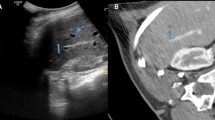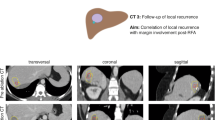Abstract
Purpose
This study was designed to evaluate the spatial accuracy of matching volumetric computed tomography (CT) data of hepatic metastases with real-time ultrasound (US) using a fusion imaging system (VNav) according to different clinical settings.
Methods
Twenty-four patients with one hepatic tumor identified on enhanced CT and US were prospectively enrolled. A set of three landmarks markers was chosen on CT and US for image registration. US and CT images were then superimposed using the fusion imaging display mode. The difference in spatial location between the tumor visible on the CT and the US on the overlay images (reviewer #1, comment #2) was measured in the lateral, anterior–posterior, and vertical axis. The maximum difference (Dmax) was evaluated for different predictive factors.
-
CT performed 1–30 days before registration versus immediately before.
-
Use of general anesthesia for CT and US versus no anesthesia.
-
Anatomic landmarks versus landmarks that include at least one nonanatomic structure, such as a cyst or a calcification
Results
Overall, Dmax was 11.53 ± 8.38 mm. Dmax was 6.55 ± 7.31 mm with CT performed immediately before VNav versus 17.4 ± 5.18 with CT performed 1–30 days before (p < 0.0001). Dmax was 7.05 ± 6.95 under general anesthesia and 16.81 ± 6.77 without anesthesia (p < 0.0015). Landmarks including at least one nonanatomic structure increase Dmax of 5.2 mm (p < 0.0001). The lowest Dmax (1.9 ± 1.4 mm) was obtained when CT and VNav were performed under general anesthesia, one immediately after the other.
Conclusions
VNav is accurate when adequate clinical setup is carefully selected. Only under these conditions (reviewer #2), liver tumors not identified on US can be accurately targeted for biopsy or radiofrequency ablation using fusion imaging.





Similar content being viewed by others
References
Park BJ, Byun JH, Jin YH et al (2009) CT guided radiofrequency ablation for hepatocellular carcinomas that were undetectable at US: therapeutic effectiveness and safety. J Vasc Interv Radiol 20(4):490–499
Miller FH, Butler RS, Hoff FL et al (1998) Using triphasic helical CT to detect focal hepatic lesions in patients with neoplasms. AJR Am J Roentgenol 171:643–649
Minami Y, Chung H, Kudo M et al (2008) Radiofrequency ablation of hepatocellular carcinoma: value of virtual ct sonography with magnetic navigation. AJR Am J Roentgenol 190(6):W335–W341
Hirooka M, Iuchi H, Kumagi T et al (2006) Virtual sonographic radiofrequency ablation of hepatocellular carcinoma visualized on CT but not on conventional sonography. AJR Am J Roentgenol 186:S255–S260
Sheafor DH, Paulson EK, Simmons CM et al (1998) Abdominal percutaneous interventional procedures: comparison of CT and US guidance. Radiology 207:705–710
Kliewer MA, Sheafor DS, Paulson EK et al (1999) Percutaneous liver biopsy: a cost benefit analysis comparing sonographic and CT guidance. Am J Roentgenol 173:1199–1202
Meyer CA, White CS, Wu J, Futterer SF, Templeton PA (1998) Real-time CT fluoroscopy: usefulness in thoracic drainage. AJR Am J Roentgenol 171:1097–1101
Froelich JJ, Saar B, Hoppe M et al (1998) Real-time CT-fluoroscopy for guidance of percutaneous drainage procedures. J Vasc Interv Radiol 9:735–740
Silverman SG, Tuncali K, Adams DF, Nawfel RD, Zou KH, Judy PF (1999) CT fluoroscopy-guided abdominal interventions: techniques, results, and radiation exposure. Radiology 212:673–681
Daly B, Krebs TL, Wong-You-Cheong JJ, Wang SS (1999) Percutaneous abdominal and pelvic interventional procedures using CT fluoroscopy guidance. AJR Am J Roentgenol 173:637–644
Paulson EK, Sheafor DH, Enterline DS, McAdams HP, Yoshizumi TT (2001) CT fluoroscopy-guided interventional procedures: techniques and radiation dose to radiologists. Radiology 220(1):161–167
Antoch G, Kuehl H, Vogt FM, Debatin JF, Stattaus J (2002) Value of CT volume imaging for optimal placement of radiofrequency ablation probes in liver lesions. J Vasc Interv Radiol 13(11):1155–1161
Schweiger GD, Brown BP, Pelsang RE et al (2000) CT fluoroscopy: technique and utility in guiding biopsies of transiently enhancing hepatic masses. Abdom Imaging 25:81–85
Sheafor DH, Paulson EK, Kliewer MA, DeLong DM, Nelson RC (2000) Comparison of sonographic and CT guidance technique: does CT fluoroscopy decrease procedure time? AJR Am J Roentgenol 174:939–942
van den Elsen PA, Pol EJD, Viergever MA (1993) Medical image matching a review with classification. IEEE Eng Med Biol 2:26–39
Sonka M, Fitzpatrick JM (2000) Handbook of medical imaging medical image processing and analysis. SPIE, Bellingham
Crocetti L, Lencioni R, Debeni S et al (2008) Targeting liver lesions for radiofrequency ablation: an experimental feasibility study using a CT-US fusion imaging system. Invest Radiol 43(1):33–39
Liu Z, Ahmed M, Gervais D et al (2008) Computer modeling of factors that affect the minimum safety distance required for radiofrequency ablation near adjacent nontarget structures. J Vasc Interv Radiol 19(7):1079–1086
Conflict of interest
The authors declare that they have no conflict of interest.
Author information
Authors and Affiliations
Corresponding author
Rights and permissions
About this article
Cite this article
Hakime, A., Deschamps, F., De Carvalho, E.G.M. et al. Clinical Evaluation of Spatial Accuracy of a Fusion Imaging Technique Combining Previously Acquired Computed Tomography and Real-Time Ultrasound for Imaging of Liver Metastases. Cardiovasc Intervent Radiol 34, 338–344 (2011). https://doi.org/10.1007/s00270-010-9979-7
Received:
Accepted:
Published:
Issue Date:
DOI: https://doi.org/10.1007/s00270-010-9979-7




